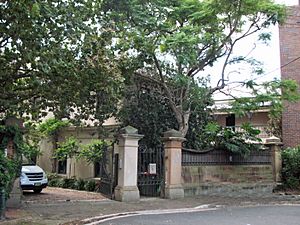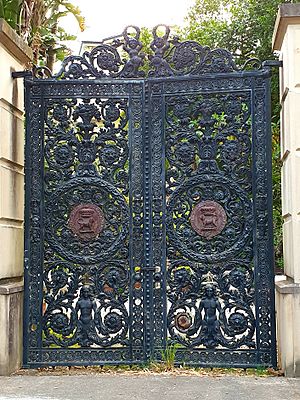Iona, Darlinghurst facts for kids
Quick facts for kids Iona |
|
|---|---|

Iona, 2 Darley Street, Darlinghurst, NSW
|
|
| Location | 2 Darley Street, Darlinghurst, City of Sydney, New South Wales, Australia |
| Built | 1880–1888 |
| Architectural style(s) | Victorian Italianate |
| Official name: Iona; Iona Cottage; Wootton; Wootton/Winchester/Hughlings Private Hospital | |
| Type | State heritage (built) |
| Designated | 2 April 1999 |
| Reference no. | 176 |
| Type | Mansion |
| Category | Residential buildings (private) |
| Lua error in Module:Location_map at line 420: attempt to index field 'wikibase' (a nil value). | |
Iona is a beautiful old house in Darlinghurst, a suburb in Sydney, Australia. It's located at 2 Darley Street. This grand home was built between 1880 and 1888. Before it became the Iona we see today, there was an older, smaller house on the same land, also called Iona Cottage. For many years, this building was used as a private hospital, known by different names like Wootton, Winchester, and Hughlings. Today, Iona is a very important historical site, listed on the New South Wales State Heritage Register since 1999.
Contents
A Look Back at Darlinghurst and Iona
How Darlinghurst Got Its Name
The area where Iona stands is high up, offering great views of Sydney. Long ago, it was called Woolloomooloo Heights or Eastern Hill. In the 1820s, Governor Ralph Darling renamed it Darlinghurst. He chose the name to honour his wife, Eliza Darling. The word "Hurst" is an old English word for a wooded hill, which described the area well.
Before it was called Darlinghurst, the area was known as "Henrietta Town." This name was given after Mrs. Macquarie, whose second name was Henrietta. At that time, it was also an Aboriginal reserve.
The First Iona Cottage
The land where Iona is built was first given to William Long in 1835. Later, in 1845, Elizabeth Grose bought part of this land. Her property was in a very popular and fancy part of Darlinghurst Heights.
From 1872, a man named Robert Carter lived in Mrs. Grose's house. This was the first time the house was called "Iona Cottage." Mrs. Grose sold her property in 1879, and the land was divided into smaller blocks. Robert Carter bought the house and made it bigger. He also changed the roof from wooden shingles to iron. He continued to live there until 1884. At that time, Iona Cottage was described as a large home with five bedrooms.
The Grand Iona of Today
In 1888, Edward Chisholm, a rich merchant from Sydney, bought the property. He built a brand new, much larger home on the site, and he also named it "Iona." Edward and his family lived in this grand house until he passed away in 1898.
In 1906, the street name was changed to Darley Street. It was likely named after Sir Frederick Matthew Darley, who was a very important judge in New South Wales. This is why the house is now known as 2 Darley Street.
Later, in 1908, Adela Taylor bought the property. She was the wife of Sir Allen Taylor, a well-known timber businessman and former Lord Mayor of Sydney. Adela renamed the house "Wootton." You might know Taylor Square in Sydney, which is named after Sir Allen Taylor!
Iona as a Private Hospital
From 1912 to 1977, Iona (also known as Wootton) was used as a private hospital. It had different names over the years, including Wootton Private Hospital, Winchester Private Hospital, and Hughlings Private Hospital.
In 1912, the Taylors sold the property to Eliza Hyem. Mrs. Hyem then leased it to three nurses who turned the house into "Wootten Private Hospital." It was a facility that helped people with mental health needs. Over the years, more parts were added to the hospital, like an operating theatre and a two-storey wing. By 1939, the hospital had 27 bedrooms!
Many large houses in Darlinghurst were pulled down between 1920 and 1940 to make way for smaller homes and apartments. But because Iona was being used as a hospital, it was saved from being demolished.
In the 1970s, developers bought Iona and many nearby houses. They planned to build tall apartment towers. However, they ran into financial problems, and the plan changed. The National Trust of Australia, a group that protects historic places, worked to save Iona. In 1976, Iona was recognized as an important part of the Darley Street area.
Iona After 1979: Restoration and Famous Residents
In 1979, a company owned by John Rutherford bought Iona. He renamed the building Iona again and planned to turn it into 15 apartments. However, this plan didn't go ahead. Instead, in 1980, the local council approved a plan to restore the building back to a single home. John Rutherford received some money to help with the restoration work.
During the 1980s, Iona was carefully restored. Old wiring and plumbing were replaced, and parts that had been added later (like enclosed verandahs) were removed to bring the house back to its original look. In 1984, the old nurses' quarters building was taken down to make the garden look better.
Around 1992, new entrance gates and pillars were added on the northern side, facing Tewkesbury Avenue. These gates are special because they feature a heraldic badge with a dog and a crown, along with the motto "honi soit qui mal y pense." This is the emblem of a very old and important British award called the Order of the Garter.
In the early 1990s, new gardens were created around the house, including a special grotto-style garden. Large palm trees were also planted.
In 1994, the Gowrie-Smith family bought Iona. Later, in 1997, famous filmmakers Baz Luhrmann and Catherine Martin leased the house. They loved it so much that in 2006, they bought Iona for $10 million! They used it as both their home and a place to work. They did a lot of renovations, adding their own designer touches while keeping the original features like the floors, tiled entry, and detailed ceilings. They even added a swimming pool.
Luhrmann and Martin tried to sell Iona in 2013 but eventually sold it in 2016 for about $16 million. The new owners are Tim Eustace and Salvatore Panui.
What Iona Looks Like
The House
Iona is a large house with 22 rooms. It's one of the few big, freestanding mansions left in Darlinghurst. The house has two floors and a basement. It's built from brick with a slate roof and has a two-storey verandah. It has been changed and added to many times over the years. The current house was built around 1888, replacing the older Iona Cottage.
In the early 1900s, it was changed into a private hospital, and many alterations were made for this purpose. In the 1980s, after the hospital closed, the house was restored.
The Garden
Today, Iona sits on a large block of land, about 2,700 square metres. It has a garden on the western side of the house. The property has two entrances: one from Darley Street with tall gates, and another from Tewkesbury Avenue with large iron gates.
The front yard has big, old trees along the edges and is mostly covered in grass. There are also some garden beds and low sandstone walls. In the north-eastern corner, there's a special grotto-style garden with sandstone walls. Behind the house, there's a recently designed yard with stone paving, garden beds, and a fountain. A very large Moreton Bay fig tree in the garden hangs over the wall facing Tewkesbury Avenue.
Why Iona is Important
Iona, built around 1888, is very important because of its beautiful design. It's a great example of a late Victorian Italianate villa, showing how architecture was changing towards the Federation period styles. The way it's built, the materials used, and its detailed decorations (especially the fancy cornices on the ceilings) make it very special.
Iona is also connected to important businessmen and public figures from that time. Historically, it was also used as a private hospital for many years, which helped save it from being torn down. Even though it was changed a lot when it was a hospital, much of its original design has been restored.
Iona was officially listed on the New South Wales State Heritage Register on 2 April 1999, recognizing its historical and architectural value.
Images for kids



